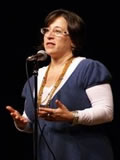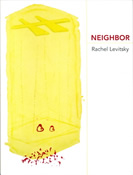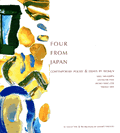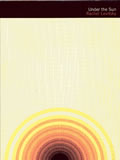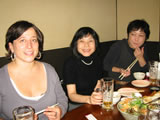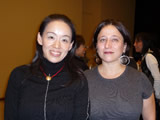Editor: Takako AraiSpecial Essays
This following is the manuscript of a speech written by Rachel Levitsky, an American poet and an organizer of Belladonna, a publication and event series that features feminist avant-garde poetry from around the world (http://belladonnaseries.org/). She came to Japan in the fall of 2008 and gave the following speech along with a reading of her poems in Kyobashi, Tokyo.
* A new collection of poems by Rachel Levitsky has been released in the United States.Rachel Levitsky, Neighbor (Ugly Duckling Presse, $15)
URLhttp://www.uglyducklingpresse.org/page-neighbor.html * Her reading at the Tokyo Poetry Festival 2008:
URLhttp://www.youtube.com/watch?gl=JP&hl=ja&v=NotvFNQDq8A
URLhttp://www.geocities.jp/tokyopoetry/
【American Feminist Avant-Garde Poetics: A Partial Take】
- High Places : No Higher Place
My Practice of Feminist Avant-Garde or
Aesthetics as Production, Production as Aesthetics
Rachel Levitsky
August 28, 2008
For we are faced with the fact—of which the past decade in Germany has furnished an abundance of examples—that the bourgeois apparatus of production and publication can assimilate astonishing quantities of revolutionary themes—indeed, can propagate them without calling its own existence, and the existence of the class that owns it, seriously into question.
Walter Benjamin, “The Author as Producer”-- 1934
I want to begin by saying that it is my delightful and rich relationships with Takako Arai, Kyong Mi Park, Kiriu Minashita, Ryoko Sekiguchi and Sawako Nakayasu that has led me to be here at this conference and at long last in Tokyo—the joyous result of a poetic practice, the aesthetics of which are, while not exactly the same as the principles by which they are produced (or amplified…), inseparable from them. Through a rambling operation called Belladonna* I invited the Japanese-American poet-translator Sawako Nakayasu to construct a “Japan Belladonna*.”
In November 2006 Sawako and myself and Stephen Motika of Poets House did this in collaboration, but it was especially Sawako’s involvement which allowed something so expansive, energetic, multi-dimensional and playfully ambitious to evolve; so that instead of our usual two poets there were four women translated, and instead of our usual one event, there were three events (Festival of Contemporary Japanese Women Poets, http://www.mi-te-press.net/eng/essay/bn200911.html), and instead of our usual chapbooks, we made a perfect-bound, beautifully designed book (Four From Japan with a cover by Kenjiro Okazaki, http://www.litmuspress.org/fourfromjapan.html). The production of the events of Japan Belladonna* followed a design that those of us organizing Belladonna* before Sawako came to work with us would never, could never have conceived—and perhaps was only ever conceived upon its completion. Of course it was wonderful, unexpected, just as it was accidental, adventurous, and it stretched us beyond what we imagined we could do. So I’d like to acknowledge Sawako Nakayasu and Takako Arai and Kyong Mi Park and Kiriu Minashita and Ryoko Sekiguchi and their visit to NYC as the precedent for me being here with you in Tokyo, and make a little toast to the world wide web of poets. And now I must turn back to the United States.
As I sit down to write this, it is the morning of August 28, 2008 and Barack Obama has been just nominated as the first Black/African-American to be selected as the candidate of the Democratic Party of the USA, in that system which is the system of the country in which I am a citizen, the one party competes seriously with only one other party, George Bush’s party, the Republican Party. As you probably know because of the dominant position of these parties and this nation globally, Barack Obama was the only serious competitor to Hillary Clinton, the first woman to get so close to where Obama got. I watched a lot of this convention on the television, something that I don’t often do. It was interesting for many reasons—for example, for the first time in my memory, each television news station had people of color (even ones who were politically positioned left of center!) and women (even queer or queer-appearing—my personal favorite was the liberal-left Rachel Maddow agreeing and guffawing with libertarian-right Pat Buchanan) as the ever-present commentators.
At the Democratic National Convention (DNC), every speaker invoked the American Dream, working hard, reaching for ever higher places. This was the theme and the content of the narrative that was, as my lover later said, ‘written, like a novel.” I felt, I could not help but feel, the emotional sway of its narrative arc. Yes, my Nico is correct, in the current political void, politics has become the new great American novel. It’s narrative rests on a binary, of highs and lows and the hope for a singular direction, up up up, toward the achievement of pre-determined goals, goals for which there are men and now women too, at the pulpit, inspiring the masses toward these elevated places which, in the United States in particular, are rhetorically, heavily, labeled ‘dreams.”
My dreams do, in fact, often place me in extremely high, far north places. In one of these dreams I drive a truck whose one unsteady lever is the only means by which I can navigate the ice roads and skirt the frigid waters. There, up north, in the landscape of my dreams I am singularly on a precipice between living and dying. It is an anxious state.
I do not know why I dream this dream. Is it because I have a secret desire to travel north, to cross the gorgeous extreme just outside the excluded middle of the United States? As a dream, is my dream an American Dream? In it, am I a rugged individual? I don’t know, but I do know that despite being asleep, in this dream of a frigid yet rapidly moving solitude I’m gripped by a wide-eyed dread.
Might I suggest then, based on my own imagination, psychology, American experience, that the American dream, as projected by rugged individualism and the need/demand to go ever higher/ever further is an anxious dream, one that makes a person fearful and skittish, one that makes pleasure and relaxation difficult, one that is implicitly against activism for in it, you are wary of the others and you are too busy watching your back; and that as a demand, this “dream” is one that sets a person up to be distrustful of the others in their midst, who, were the dream not constructed so individually, might be the dreamers’ companion, conversant, community.
But, before plunging into my refusal: of the Rhetoric of the Climb (as rock-climbing becomes an increasingly popular sport), let me say that in the context of the Democratic National Convention (DNC) and our first black presidential candidate, the first woman near candidate, I do recognize that the rhetorical dream of heights so often referred to at the DNC is also of the dream of a plural, egalitarian society. By pointing to and critiquing the rhetoric of the Climb, I’m not suggesting that women or people of color or poor people or anyone outside the dominant white heterosexual glib dominant class should be happy to live submissively, in hardship, and not want any better. Far from it, I may be suggesting we consider ourselves those very people, and that we fight this submission, these hardships, structurally, not individually.
Therefore, I am questioning this hierarchical model of upward (which implies the inverse: downward) movement as the one kind by which life and its most luminous and sublime products come to exist. As a writer, my product, my means of producing, is language, and the product is text, in the form of files, books, journals, magazines, emails, blogs, slogans, posters, polemic, letters, speech, performance. The work we writers make is itself more work for the consumer and therefore, it will likely never make much money for any of us. Left without the dream of big dollars, poets in the United States sometimes end up clawing at each other in an projected economy of “prestige,” though this notion in such a capitalist society seems to me to be counter-intuitive--for prestige and prizes unattached to money in the United States means little to the technocrats and merit-o-crats who hold power in the United States. And it never has. Witness the fate of your (name here: ____) favorite American writer. How many books did they ever sell during their lifetime? We know this, and yet the Climb, the hierarchical, great man approach persists among writers. It is the narrative in which one aims to be pronounced “The Greatest Writer of …” by someone like Harold Bloom. And it is the narrative of dogmatic movements later to be known too much by a singular “leader,” – in which Ezra Pound and André Breton come to mind, the others relegated to the fate of anthological afterthoughts and recovery scholarship, especially the women (Penelope Rosemont’s Surrealist Women Anthology is a good example here). Though there is much to be said for these rescue projects and the stories and work that emerge through them and the value of their use, what I propose is another means of production, one that I did not know about until it was happening and I was doing it.
In 1999 I began to organize Belladonna*1 under the following mission statement:
Belladonna* is a feminist avant-garde event (Belladonna Series) and publication project (Belladonna Books) that promotes the work of women writers who are adventurous, politically involved, multi-form, multicultural, multi-gendered, unpredictable, dangerous with language (to the death machinery).
Rather than address a lack of representation of women poets in anthologies or poetry readings or book titles, Belladonna* sought and seeks to address the way in which poetry is organized. We hold no contests and we offer no prizes. We don’t even have an official submission process. What we do instead is precipitate poetry production by relationship, correspondence, aesthetics and community. We pursue poets everywhere and in every community who are doing work that we think is important because of its innovation of form and political demand.
These are some of the features of our production that I think offer a model for building a meaningful, non-hierarchical writing community:
1) Conversation. We work with poets with whom we are in conversation. When poets who we don’t know approach us for a book or a reading, I encourage them to keep in touch with us about their projects.
2) Anarchy. Often, eventually we end up producing with, making something unexpected with, these (mentioned above in the first bullet) very poets who approach us because they admire us or want us to make them a book. Our organizational structure is open, anyone who feels aligned with what we are doing can come in and do something, without supervision or in conjunction with us but guiding us, not us guiding them. As my story at the beginning shows, this is how we ended up organizing Four From Japan. The longer I do this, the more people I work with, the more I am convinced of the futility of controlling and managing others.
3) No rejection. Once we and a poet agree to work with each other we accept whatever they give to us to publish. We already know we want to support them and we know that often, interesting work is unrecognizable to editors.
4) Collaboration. Not only do many of our poets collaborate with each other, we collaborate with them on how things happen.
5) Aesthetic Desire. I mentioned before we don’t have a submission process and our purpose is not to redress gender inequality. Our collecting of the work of the feminist avant-garde into a visible aesthetic community is an endeavor of passionate longing.
6) Parity, Diversity, Translation. Of the 150 poets that are included in our list, one may find a wide demographic: women, men (a few), lesbians, transsexuals, poets writing in English, French, Chinese, Japanese, Spanish, Black poets, Latina poets, poets from Mexico, Canada, Chilé, Argentina, Puerto Rico, Ireland, India, China, Philippines, Korea, Japan, the Middle East, middle America, urban America, old poets, young poets, working class, poor, rich…
7) Aesthetic Clarity. Diversity/inclusivity is central to our effort but it is perhaps matched in equal measure by singularity/exclusivity. We engage a certain kind of poetics, a poetics that is notable for its political and critical engagement, for formal innovation, for hybrid experimentation, prose that is situational not plot-driven, poetry that is inter-subjective or performative or witnessing, not personally revelatory, work that reaches across the boundaries and binaries of literary genre and artistic fields. Work that questions the gender binary.
Belladonna* is a far cry from the only avant-garde poetry collective producing books and other literary forms by these means of meandering, rhizomatic, non-hierarchical, non-merit-o-cratic correspondences. Ugly Duckling Presse, Switchback, Booklyn, Krupskaya, Sous Rature, pressgang, all come immediately to mind but there are tons of others. Each year, Poets House(http://www.poetshouse.org/), a fairly small organization that helped us a lot with Four From Japan, hosts a Showcase of 2,000 or so volumes of poetry and poetry related material produced independently that year. To see it, to be at this event, is to witness the non-capitalist life that, in the United States, flourishes outside the hegemony of the Climb.
For me, as a producer of text and a producer of texts, the issue is not for activists and feminists to be on one hand innovative writers and on the other, helpers of those in trouble (your tired, your hungry, your poor), but rather to understand themselves as part of the trouble, to understand systems as unified. I am certainly not the only one of us whose job doesn’t quite pay enough to live, who has no health insurance, who wonders why we aren’t organizing ourselves more effectively against these matters.
1 The asterisk refers to the definition of the Belladonna flower: “deadly nightshade, a cardiac and respiratory stimulant, having purplish-red flowers and black berries.”
Copyright © Mi’Te press. All rights reserved.
Designed by MOGRA DESIGN

